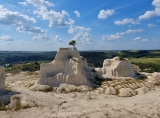If you want to know a monument of architecture with an age of tens of millions of years, you must reach the Butești Gorges, also known as the Butești Gorge or Reef, located only 70 km from La Fetești.
The gorges are considered to be some of the widest in the Middle Prut basin. They were dug by the Camenca River in the organogenic reef in the form of a canyon with a length of about 1.8 km or over 2 km.
Geological formations, like other limestone reefs in northwestern Moldova, formed in two stages, 15-20 million years ago. In the first stage, the basic limestones were formed in the waters of the Baden Sea, mainly from corals, foraminifera, bryozoans, blue-green algae and shells of different mollusks. In the second stage, the Volhynian limestones were formed more from bryozoans, foraminifera and blue-green algae in the warm waters of the Sarmatian Sea and the Tortonian Sea.
Skeletons of ostracods, crabs, hedgehogs, mosses, lithotamnius, less often prints of fish skeletons, parts of seals, dolphins and other animals have also been discovered in the reef.
Traces of a Neolithic fortress have been preserved on the reef, protected by steep banks and a wave of earth.
In the walls of Butești reef there is a cave and some unstudied caves. In it, after some preventive investigations, were found traces of an ancient archaeological culture, attributed to the Neolithic or, according to other sources, the Paleolithic and Mesolithic.
On the surface of the gorge formed by the Camencuța stream (a tributary of the Camenca), in its right slope, another cave was discovered, following an explosion during the extraction of the stone. The explosion brought to the surface a large amount of fossilized bones, including fragments of skulls, mandibles, solitary teeth, limbs and other skeletal parts, a total of about 3,000 reminiscences. The bones belong to large mammals, such as the cave bear, the cave hyena, the bison, the giant deer, the noble deer, the marmots, etc. Also, archeological vestiges were discovered, such as arrowheads, scrapers and other objects made of flint, piercers and bone grooves, handles made of deer antlers, etc. They come from a tribe of prehistoric Neanderthal hunters, bearers of the Mustie culture, who lived here about 70-80 thousand years ago.

Pommer mansion in Țaul park
One of the most beautiful mansions in the largest park in the Republic of Moldova.

“Adormirea Maicii Domnului” Monastery from Călărășeuca
A soulful monastery, surrounded on three sides by rocks and forest, on top of one of the rocks with a cave hermitage and the cross installed next to it.

Nature Reserve Pădurea Domnească
Seven gorgeous smiles and multisecular oaks about 250 years old and with heights of over 35 meters, can be admired in the Princely Forest Nature Reserve.

Drink tasting at Barza Albă
Want to taste a half-century-old divine among thousands of oak barrels?

Grigore Vieru House Museum
Feel the atmosphere of the places where the famous Grigore Vieru Square grew up.

The mansion of the Ohanowicz family
A place full of riddles and legends, located in a park of 16 ha, designed by Alexandru Bernardazzi.

Constantin Stamate Memorial House
A museum with 350 items, including: furniture, books, photos, newspapers and magazines.

Old Duruitoarea Cave
The location where the first traces of prehistoric man from Moldova and Romania were discovered.

"Naşterea Domnului" Monastery from Zăbriceni
A monastery of rare beauty, with the largest theological library.

 EN
EN RO
RO RU
RU



















